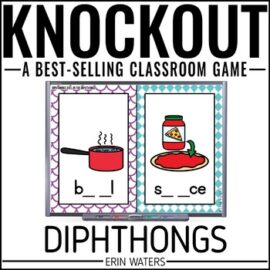The closing circle is a valuable practice that can bring a sense of closure and reflection to the end of the school day in an elementary classroom. By implementing a structured routine and involving students in the process, teachers can create a calm and meaningful space for students to wrap up their day. In this blog post, we will explore practical tips to establish an effective closing circle that maximizes its benefits while minimizing chaos.

What is a closing circle?
Let's start with the basics: What exactly IS a closing circle? The closing circle is a designated time at the end of the day where students gather to reflect, share, and wind down together. By establishing a closing circle, teachers provide a structured opportunity for students to process their experiences, build community, and reinforce important skills. Benefits of a closing circle include:
- Reflection: Students have a chance to reflect on their day, identifying the high points (peaks) and challenges (valleys), fostering self-awareness and emotional intelligence.
- Community Building: Sitting in a circle promotes a sense of togetherness, allowing students to listen and learn from one another's experiences.
- Recognition: Students can express gratitude and acknowledge their peers for positive contributions, cultivating a supportive and inclusive classroom environment.
Making the Transition to the Closing Circle
The Importance of Student Jobs
To streamline the transition to the closing circle, assign student jobs for the last 20 minutes of the school day. These jobs could include cleaning the floor, distributing student folders, organizing supplies, or any other tasks that commonly arise. By involving students in these responsibilities, you accomplish two goals:
1 – Responsibility and Ownership: Assigning specific tasks empowers students to take ownership of their classroom environment and reinforces a sense of responsibility.
2 – Smooth Transition: By designating jobs, you ensure that logistical tasks are taken care of efficiently, creating a smoother transition to the closing circle.
Setting a Timer
To ensure ample time for a thoughtful closing circle, set a timer and encourage students to beat the clock. By creating a sense of urgency and making it a challenge, you motivate students to complete their tasks promptly. A rushed, panicked closing circle can hinder its effectiveness, so allowing adequate time for reflection is crucial.

I lovingly called this “Beat the Clock” and would show on on-screen timer (do a simple Google search, there are tons!). Every time we beat a previous record, I would write it down on a paper next to our whiteboard. It became our class mission to beat that time with each subsequent cleanup!
Fun Fact: My afternoon meeting slides now feature a fun clean-up countdown to motivate your students! I even created a record keeper that you can hang by your whiteboard to see how quickly your students can hone in on their best time! (see above!)
Assembling in a Circle with Closing Circle Prompts
Once the end of the day tasks are completed, gather students on the carpet in a circle. Utilize the whiteboard to display closing circle prompts. Some examples of prompts include:
- Peaks and Valleys: Invite students to share the best part (peak) and the most challenging part (valley) of their day, fostering self-reflection and empathy.

- Student Shout-outs: Provide an opportunity for students to recognize and appreciate their peers who had a positive impact on their day, reinforcing a supportive classroom community.

- Learning Reflections: Ask students to share something new they learned or a skill they improved on during the day, promoting metacognition and growth mindset.

You may choose a different set of students each day to respond to the prompts, or you may choose day by day and ask students to volunteer their ideas. You may also choose to randomize the process by using a name generator or picking from a set of craft sticks with student names on them.
The Importance of Reflection in the Classroom
Reflection is a powerful tool for both students and teachers. During your closing circle, encourage students to reflect on their day by actively participating in the closing circle prompts. Similarly, teachers should take time to reflect on the day's successes and challenges. Benefits of afternoon reflection include:
- Self-awareness: Reflection helps students become more aware of their emotions, strengths, and areas for growth.
- Improved Learning: By reflecting on what they have learned, students solidify their understanding and identify areas that require further attention.
- Teacher Growth: Teachers who reflect on their practices can make informed adjustments, improving their instructional strategies and classroom management.

Keep Your Closing Circle Consistent
Consistency is key to the success of the closing circle routine. While it might feel tempting to rush through it or skip it altogether on those extra wild days, making sure you end your days on a note of togetherness and intention is going to have a huge impact on your classroom culture.
In addition to keeping your closing circle routine consistent, maintaining the same format will reduce the time spent giving students instructions, answering questions, and will give you a springboard for meaningful time instead of playing another game of carpet Whack-a-Mole.
Incorporating a closing circle at the end of the school day can transform the dismissal time in an elementary classroom from chaotic to calm, fostering reflection, community, and growth. By knowing what you want out of your closing circle, involving students in tasks through designated jobs, setting a timer, and providing prompts, teachers can create a meaningful space for students to wrap up their day. Reflection, both for students and teachers, is a powerful tool that promotes self-awareness, learning, and continuous improvement.
So, take the initiative to implement a closing circle and witness the positive impact it has on your students and classroom dynamics. End your day with a closing circle, and say goodbye to chaos and hello to a purposeful and reflective end to each school day.
Interested? I wrote another blog post that dives even deeper into this game-changing classroom tool. You can check it out here. Thank you so much for reading!








 Arm you with high-quality tools: Sleep peacefully at night knowing you’re doing what’s best for your students.
Arm you with high-quality tools: Sleep peacefully at night knowing you’re doing what’s best for your students. Save your energy: Provide resources that cost you little energy (that stuff is precious)---but have high impact on your students.
Save your energy: Provide resources that cost you little energy (that stuff is precious)---but have high impact on your students. Light your spark: Putting fun back into your classroom after the hardest teaching years can be just what you and your students need.
Light your spark: Putting fun back into your classroom after the hardest teaching years can be just what you and your students need.
Leave a Comment